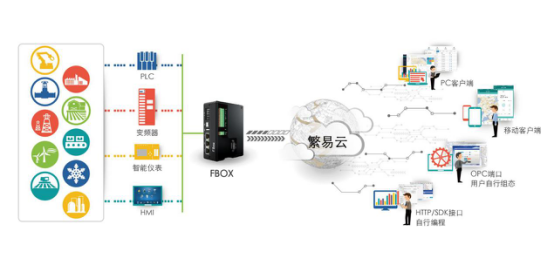Introduction to FGate
Flexem Box, abbreviated as FBox, is an intelligent industrial Internet of Things (IIoT) transmission terminal device in the FlexManager platform of Fanyi IoT.
FlexManager system
The FlexManager system, also known as Flexem Cloud, enables the transfer of large volumes of data or programs from various industrial equipment in different locations to a remote cloud data center via the Internet (Ethernet, GPRS, 3G, etc.). It provides functions such as remote data monitoring, equipment diagnostics, program maintenance, and fault alarms, offering users a simple and reliable solution for remote data transmission in industrial IoT applications.
The components of the FlexManager system include:
| Component | Description |
|---|---|
| Device End | FBox and connected device controllers, HMIs, and instruments. |
| Server End | FlexManager cloud server cluster or user-built private cloud server. |
| Client End | PC client/web client, mobile app, as well as OPC/SDK, etc. |
The relationships between the various components of the FlexManager system are depicted in the diagram.

In the FlexManager system, the cloud server is used to connect a large number of FBox devices on-site, achieving functions such as connection management, data collection, storage, and transmission of a large number of remote devices. It serves as the hub of the FlexManager system.
The FBox device serves as an intelligent transmission terminal bridging the connection between on-site devices and user clients, responsible for connecting industrial on-site equipment to the cloud server.
Features of FlexManager System:
Supports wired, GPRS, and 4G connections without complex configuration, making it easy and convenient to use.
Supports remote program download and monitoring for the majority of PLCs, reducing the need for user travel.
Supports VPN with one-click connection for simplicity and convenience.;
Enables remote data monitoring via computer client, mobile app, and web.
Supports data alarms; mobile app can push alarm messages and also configure SMS and WeChat notifications.
Records historical data, collects and logs data from monitored points, and supports data display in list and curve formats, along with common statistical analysis.
Supports remote shutdown function, binding the box with PLC connection for remote control shutdown, facilitating remote device management such as rental equipment.
Open interfaces support OPC interface for user configuration; also opens HTTP and SDK interfaces for user programming.
Supports hierarchical permissions for different account information, facilitating use by equipment manufacturers and end customers.
FBox Devices:
FBox devices are the latest remote communication devices in the Fanye Internet of Things platform (FlexManager), enabling convenient remote interconnection, remote download, and remote maintenance of on-site equipment.
There are six types of FBox devices: FBox, FBox-VPN, FBox-2G, FBox-4G, FBox-2G-lite, and FBox-WiFi. The FBox Ethernet version does not have an antenna port.
In the FlexManager system, the cloud server connects remote clients with industrial on-site equipment through FBox devices. FBox devices are based on ARM CORTEX A8 processor cores, with three Ethernet ports, three serial communication ports, and the capability to connect wirelessly via WIFI/GPRS/4G. In practical applications, FBox products are installed in on-site cabinets and connected to PLCs, smart meters, or variable frequency drives via serial ports or Ethernet ports. FBox products publish data from these PLCs or instruments to Internet cloud servers via the Internet, allowing users to view device data, understand device operation status and alarms, remotely debug PLCs, and monitor cameras, among other functions, anytime, anywhere.
Through FBox and remote client software, users can conveniently update PLC and human-machine interface programs remotely via the Internet, query and analyze on-site data, diagnose problems, remotely maintain configurations, view real-time images through cameras, collect operational data more conveniently, issue fault alarms and maintenance warnings, and make improvements based on collected data for better product optimization.
FBox devices can be widely used in various industries such as air conditioning, water supply, building automation, heating, cold storage, experimental equipment, air compressors, packaging, printing, textiles, rental equipment, environmental protection equipment, and unmanned pump stations.
Features of FBox Devices:(except FBox-2G-lite)
ARM CORTEX A8 high-speed CPU.
Built-in network switch supporting 3 Ethernet interfaces for easy on-site networking.
Multiple wireless interconnection methods: optional WIFI/GPRS/4G support.
Three serial communication ports: COM1 (RS232/RS485/RS422), COM2 (RS485), and COM3 (RS232).
2 channels of optoelectronic isolated digital input, 2 relay outputs.
SD card, USB HOST support 16G external storage SD card or U disk.
USB SLAVE for downloading configuration and debugging programs.
FBox Client
Accessing or operating FBox devices requires the use of the FBox client.
The FBox client is divided into PC client, WEB client, and mobile client (Android App and IOS App). The PC client can achieve remote monitoring, downloading, data reading and writing, fault alarms, video monitoring, and historical data recording; the WEB client can be accessed directly through the browser or cross-platform, but does not support remote downloading; the mobile client supports Android or IOS systems, and can achieve alarm push notifications, but does not support remote downloading.
In the FBox client, corresponding software needs to be installed to access FBox devices.
FBox client software (FlexManager) is divided into PC client software and mobile client software (FBox mobile APP). PC client software is used on the PC side for remote monitoring, downloading, data reading and writing, fault alarms, video monitoring, and historical data recording. Mobile client software is installed on mobile devices such as smartphones, providing functions such as data reading and writing, fault alarms, and historical data recording.
These software can be downloaded from the http://www.flexem.cn website.